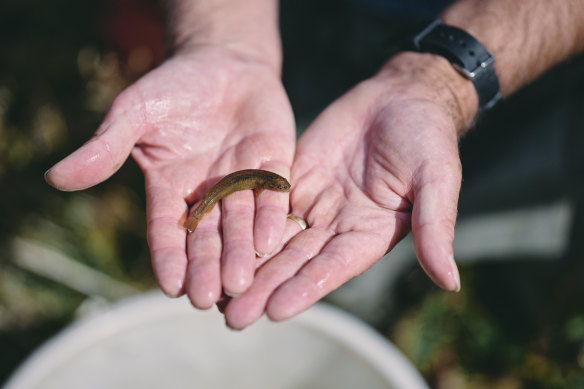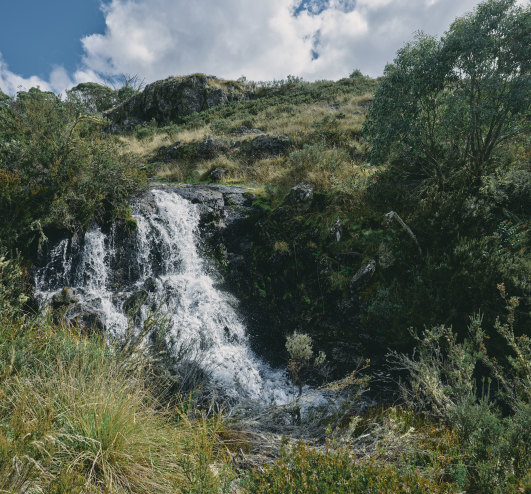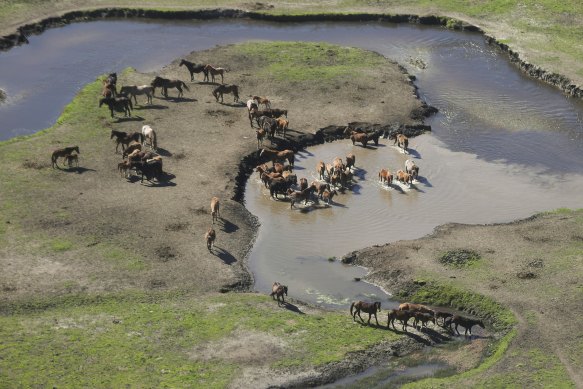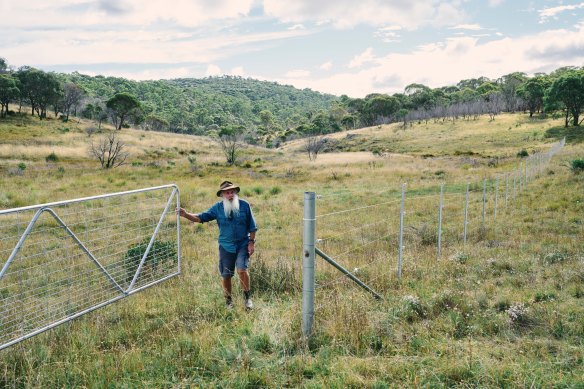
It’s love at first sight. On a clear autumn afternoon, I join a small group of tourists at Gaden Trout Hatchery, on the Thredbo River outside Jindabyne, in southern NSW. We watch a video explaining that trout were introduced to the Snowy Mountains in the 19th century, then we’re invited to feed some other fish in the outdoor ponds.
We are ushered to a handful of fish tanks in a large, chilly shed. Our guide explains that the solitary fish in the tanks before us are critically endangered and were rescued from a location in the north of Kosciuszko National Park during the Black Summer of 2019-20. Attempts are being made, he says, to establish a population in captivity, a hedge against further disaster that could wipe out the little fish in its native habitat.
“Are they stocky galaxias?” I gasp.
He eyes me inquisitively. “What do you know about stocky galaxias?”
I’ve absorbed snippets about this native fish over the past couple of years: it is tiny, threatened and squeezed by multiple adversaries. I know there are heroes both human and geographic at work for its survival.
As its natural habitat is a small stretch of sub-alpine stream in an isolated reach of Kosciuszko National Park, I never imagined I would come face-to-fin with one.
The group wanders on. I linger, a star-crossed fangirl gazing at these mysterious fish, each in its own aquarium. Their tiny bodies, less than 10 centimetres long, nimbly circuit their living space, revealing shimmering golden bellies as they wriggle up the glass.

Stocky galaxias is under imminent threat of extinction. Credit:Rohan Thomson
Fish in the galaxiid family are found in New Zealand, South Africa, New Caledonia and South America as well as Australia, suggesting they’ve been around since the existence of the giant Gondwana land mass, which began its slow breakup about 180 million years ago. Stocky galaxias (Galaxias tantangara) was described as a new species in 2014 by Tarmo Raadik, senior research scientist at Victoria’s Arthur Rylah Institute. He discovered the stocky galaxias in a four-kilometre trickle of Tantangara Creek, a mountain stream in the northern reaches of Kosciuszko National Park, in the Snowy Mountains.
Raadik had been studying the mountain galaxias (Galaxias olidus), a small, native freshwater fish with an extensive distribution in south-eastern Australia, finding not just one but 15 individual species, describing 12 as new to science. Stocky galaxias, unique in Australian river systems, is one of these new species.
Loading
“I went to Tantangara because there was a really old specimen, from the 1800s, in the Australian Museum,” Raadik explains. “I went along a trail and stopped where it crossed Tantangara Creek. I sampled that area and all I found were brown and rainbow trout, predators of galaxiids.”
As he was eating his lunch beside the creek, Raadik heard running water in the dense vegetation behind him and followed the creek upstream. “I found a waterfall, which would be a good barrier, stopping trout,” Raadik recalls, “and immediately climbed above it. And there were the [stocky] galaxiids. I could so easily have moved on without knowing they were there.”
Since Raadik published his paper in 2014, the number of known species in the mountain galaxias complex has grown from 15 to 21, with potential to discover more species within our freshwater river systems. “South-eastern Australia is the most biodiverse area for galaxiids on the planet,” says Raadik. “It is so important to both acknowledge and protect what we find.”
Because stocky galaxias was found only above the barrier waterfall in the upper reaches of Tantangara Creek, the species was urgently listed as critically endangered in NSW. An estimated 2000 mature individuals are thought to live in Tantangara Creek. Stocky galaxias is under severe and imminent threat of extinction, from factors both inside and outside the stream in which it lives.

The waterfall on the creek that so far has been a barrier to invasive trout.Credit:Rohan Thomson
For some years after their discovery, it was believed the only place in the wild that stocky galaxias existed was in Tantangara Creek. But in the spring of 2020, Mark Lintermans, associate professor in freshwater fisheries ecology at the University of Canberra, and PhD student Hugh Allan arrived at Sallys Flat Creek – about 30 kilometres north of Tantangara Creek on a map, but more than 350 kilometres via waterways – in the northern stretch of Kosciuszko National Park. Lintermans and Allan were to study bushfire impacts on Riek’s freshwater crayfish (Euastacus reiki), a threatened native species that lives in burrows near stream beds. Tiny, shiny and the highest-altitude species of crayfish in Australia, it fits the bill for Lintermans’ loves: small, endangered and relatively unknown.
During the cray survey, Lintermans and Allan captured fish specimens from Sallys Flat Creek. Among mountain galaxiid species, which can climb out of the water to sunbathe on streamside rocks, Lintermans was thrilled to find stocky galaxias, suggesting that before invasive trout infestation, the latter populated a much larger range.
To discover a second wild population is wonderful, Lintermans enthuses. “The second population may be smaller than the first, but at least it gives us a bit of breathing room,” says the 64-year-old. “If we lose one [natural habitat], we’ve still got another.”
Last month, Lintermans conducted a population assessment at Sallys Flat Creek, finding that among the 1000 fish there about half were stocky galaxias, but the population estimate has yet to be confirmed.
Lintermans, who has a flowing white beard and a youthful agility to bound over uneven streamside ground, believes that Australia’s small native fish are forgotten in conservation efforts. In a 2020 paper, he, Raadik and others reported that of our 22 freshwater fish species most at risk of extinction in the next 20 years, 21 grow to a length of 15 centimetres or less. Twelve have been described by science only in the last decade. “We’re not even close to describing our freshwater fish fauna,” Lintermans insists.
In 2021, the federal environment department published its 100 Priority Species list, populated by native plants and animals in danger of being wiped out. Species named on the list – which includes the koala and red-tailed black cockatoo – can be saved with cost-effective human intervention. More than 1800 native Australian species were considered for the list; four freshwater fish are included, and stocky galaxias is one of them. This little fish is in the unenviable position of suffering savage impacts from a trifecta of contentious issues within Kosciuszko National Park.
Loading
Smaller native fish form some of the diet of introduced trout species, which jump from pools beneath natural barriers (such as small waterfalls) into higher reaches of river systems. The height and sheer face of waterfalls at Tantangara and Sallys Flat creeks have so far been an effective natural barrier against trout. Second, the heavy bodies and hard hooves of wild horses in Kosciuszko National Park trample delicate edges of waterways, destroying streamside vegetation and causing a build-up of sediment that can starve fish and their eggs of oxygen. The third risk to stocky galaxias in Tantangara Creek is the mixing of inland waterways by Snowy 2.0, the large-scale hydroelectric power project currently under construction inside and outside Kosciuszko National Park.

Wild horses in the Kosciuszko National Park near Tantangara. Credit:Alex Ellinghausen
Snowy 2.0 was announced by then-prime minister Malcolm Turnbull in 2017 and given the green light in 2020 despite noisy opposition from scientists and environmental groups. Its projected completion date is 2026, with a budget blow-out of billions. Along the Snowy Mountains Highway inside the national park between Adaminaby and Tumut, a hive of construction is under way: trucks haul loads of rock material, new roads are under construction, and access to some areas of the national park has been closed to the public by metal gates.
The completed hydroelectric project will pump water between Talbingo Reservoir, which is part of the Tumut River system, and Tantangara Reservoir, part of the Upper Murrumbidgee system. Transfer of water between the two, previously unconnected, risks the introduction of two invasive fish species to the Murrumbidgee, of which Tantangara Creek is a tributary: redfin perch, which has the potential to destroy endangered Macquarie perch populations via a virus it carries, and climbing galaxias (Galaxias brevipinnis).
Climbing galaxias, which can grow longer than 25 centimetres, is a species native to Australian coastal waterways, not inland streams. It was introduced to the Tumut River system during the Snowy Mountains Scheme, built during the second half of last century, and has established a population in Talbingo Dam.
As its name suggests, climbing galaxias could use its pectoral and anal fins to climb the periphery of the waterfall at Tantangara Creek and invade the stream above. From there it could prey upon stocky galaxias and compete with its smaller cousin for food. In this scenario, the waterfall barrier that has so far protected the stocky galaxias from trout would become obsolete.
“Climbing galaxias are implicated in the decline of galaxias species in Tasmania and New Zealand, and they could eliminate this population,” says Lintermans, who was chair of the NSW Fisheries Scientific Committee until 2020, when he resigned to protest NSW Government approval of Snowy 2.0.
In its environmental assessment process, Snowy Hydro – the company building Snowy 2.0 – found the transfer of fish and larvae between the two reservoirs was a possibility. While Snowy 2.0 is working proactively with government agencies, I was unable to secure a live interview with any officials despite multiple requests. I had questions about measures to protect stocky galaxias; I was emailed written responses.
Loading
An effective screen at Talbingo Dam would prevent invasive fish and their larvae from entering the Upper Murrumbidgee system at Tantangara Dam, which would keep new pest species out. Installation of this type of screen would require further blasting and disruption of water and land during construction. Snowy 2.0 estimates the screen would cost $619 million to install, with $4 million in annual operating expenses.
Instead of comprehensive screening at Talbingo Dam, Snowy 2.0 plans to install a physical fish barrier above the waterfall at Tantangara Creek. This waterfall barrier is intended to stop climbing galaxias, should it successfully establish a population in the Upper Murrumbidgee and move through the river system to Tantangara Creek, from advancing further into the stream and invading the stocky galaxias population.
A barrier at Tantangara Creek would not prevent climbing galaxias infestation throughout the rest of the Upper Murrumbidgee system, including potential habitat for reintroducing stocky galaxias, or other populations not yet discovered. During high water flows after heavy rain, or via a small stream diversion, climbing galaxias could find a way around the barrier screen.
Now for some good news: late last year there was a breakthrough in breeding stocky galaxias at Charles Sturt University following years of failure. Dr Amina Price, fish ecologist at the Gulbali Institute at CSU, explains that the team hand-stripped male and female fish and fertilised the eggs in a petri dish. The first stocky galaxias babies hatched just after Christmas and now number about 100. “It is all the more exciting that we have as many fish as we do on our first attempt at hand-stripping,” says Price.
In autumn last year, I joined Mark Lintermans on a drive to Tantangara Creek along a rough dirt track. Much of the creek is now inside a 180-centimetre-high protective metal mesh fence, completed in autumn 2021, which was built to prevent wild horses from trampling the edges.
Lintermans led the rescue mission here that scooped 142 stocky galaxias from the creek on January 14, 2020, as catastrophic bushfires raged uncomfortably close. The rescue was carried out, he explains, because violent storms were forecast for the area. These would pose a greater threat to stocky galaxias than the bushfires themselves: after fire, heavy rain washes ash and burnt vegetation into a stream, smothering waterways with a build-up of sediment that can starve fish and their eggs of oxygen and destroy essential habitat. In the medium term, decomposition of burnt plant matter can withdraw more oxygen from the water. “Streams are linear systems,” Lintermans explains. “Fish can’t step out to let the dirty water go past.”

Lintermans at the fence built two years ago to protect stream edges from trampling by wild horses.Credit:Rohan Thomson
Distributed between Charles Sturt University and Gaden hatchery, the rescued fish are housed in individual tanks because stocky galaxias is an aggressive fish in captivity, fighting with and occasionally killing its own kind. “The stocky galaxias probably isn’t a keystone species. If we lost them, the stream would survive,” Lintermans sighs. “But every animal is a brick in the wall. You can lose a brick without the wall falling down. But lose too many bricks …”
Since the fence was completed, grasses and shrubs have re-established on bare sections of creek edge. What won’t return as rapidly are the large mounds of sphagnum moss that were scorched in 2020.
Having observed a healthy sphagnum bog at high altitude elsewhere, I regard it as a magical thing to see. Sphagnum varies in colour from pale green to soft pink and is extremely absorbent. It retains water, which is slowly released during dry periods, ensuring the continuous flow of small streams like Tantangara Creek. Yet here at upper Tantangara, what was once a large sphagnum bog is now a patch of lifeless, desiccated charcoal. Dusty piles, the texture of dead sea sponge, remain. When I climb over a section to reach the creek, it emits a puff of dark dust. The black sphagnum is silent, devoid of bird and insect life that thrives nearby.
Gabriel Wilks, senior project officer at NSW National Parks, emphasises the significance of this one narrow waterway. “Sphagnum is critical to the ecosystem. It’s an important part of filtration at the source of our river systems.”
Driving out of the national park along a bumpy trail peppered with eucalyptus saplings, Lintermans reflects on his decades-long fight to highlight the plight of Australia’s lesser-known threatened species. “I’ve enjoyed fish all my life,” he says. “I just like knowing they’re there. I want my grandkids to be able to have that same experience. I want my grandkids’ grandkids to feel the same. And this is my job. My task is to protect fish, and I’m not going to lose any on my watch. If more people felt like that, we wouldn’t be in the strife that we’re in.”
Lintermans and Wilks are part of a widespread team of dedicated conservationists working to keep stocky galaxias alive. The NSW Department of Primary Industries (Fisheries) and NSW National Parks collaborated to create a refuge habitat at Eucumbene Borrows, on the south-west reaches of the Lake Eucumbene, within Kosciuszko National Park. As the streamside vegetation is now sufficiently established, the stocky galaxias babies bred at Charles Sturt will be released here late this month.
The goal is to establish an insurance population, should multiple disasters strike at Tantangara and Sallys Flat creeks. Why all this trouble, to rescue one fish? “Why not fish?” Lintermans smiles. “Fish are fantastic.”
Loading
The refuge uses the lakeside remnants of a quarry from the first Snowy scheme. Over decades of disuse, old clay pits have become a series of ponds. Far from the cold, high-altitude streams where wild stocky galaxias have been found, the refuge includes modification of existing ponds, construction of fencing to keep invasive deer out, cultivation of plants along the stream edges, removal of trout and establishment of a solar-powered water pump, to mimic the continuous flow that scientists believe stocky galaxias needs to thrive and breed.
The project is partially funded by a bushfire recovery grant, and supported by the local community. Government expertise and citizen science come respectively from South East Local Land Services and Waterwatch. Cameron Lay, director of freshwater environment at Fisheries, says, “We need community buy-in to keep this project alive. It can’t all be the responsibility of government. We have passionate community members who get out there and help us.”
Some endangered animals on the national 100 Priority Species List are charismatic, cuddly and famous but many, including stocky galaxias, remain largely unknown to anyone outside the small network of people intent on saving them. “Losing any part of an ecosystem has consequences, and we don’t know what they are,” reflects Cameron Lay. “We are keen that we don’t lose this species, no matter how small its distribution may be.”
This singular, delightfully quirky tiny fish, unaware of the outsized threats it faces, and the lengths taken by passionate people to save it, now has a chance. And it depends on a band of dedicated, mostly unsung people who devote their lives to the conservation of obscure threatened species.
To read more from Good Weekend magazine, visit our page at The Sydney Morning Herald, The Age and Brisbane Times.



























